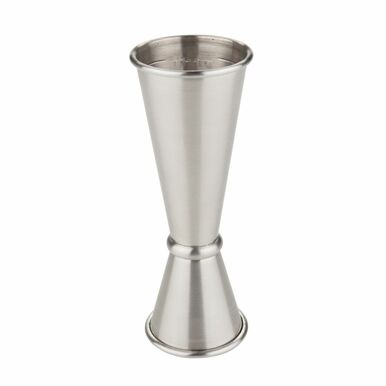Bartenders use jiggers to ensure accurate amounts of alcohol are dispensed. Typically, they are hourglass-shaped with two sections of different sizes – one typically measuring 1.5 ounces or 44 milliliters, and the other 1 ounce or 30 milliliters. Additionally, some jiggers are inscribed with measurement markings, providing more precise liquid measuring.
When concocting a cocktail, using a jigger to precisely measure the ingredients and alcohol is vital for obtaining the desired balance and flavour. Indeed, a deviation from the suggested quantities of ingredients and alcohol will directly impact the taste and strength of the final product.
Instead of a jigger, a measuring cup or spoons could be used; however, when it comes to accuracy, jiggers offer a greater level of precision for bartenders.
What is a Jigger Measurements?
When mixing drinks, a jigger is the customary tool used to measure a precise amount of liquid. Generally, the jigger contains 1 or 1.5 ounces (or 30 or 44 milliliters), although the volume can vary according to the size of the tool.
The average jigger measures 1.5 oz on one side and 1 oz on the other; this combination is quite popular and is used frequently in bars and restaurants across the globe.
It is imperative to be mindful that jigger measurements can vary depending on the producer. Consequently, it is important to ensure that you confirm the measurements prior to using them.
Crafting a perfect cocktail requires exact measurements and the right equipment. An inexact ingredient or the wrong utensil could drastically alter the drink’s flavor, leaving you with an unexpected escort kadikoy outcome.
Types of Liquor Shots
| Type of pour | Amount to pour (oz) | Amount to pour (ml) |
| Jigger Shot | 1.5 oz | ≈ 45 ml (44.36) |
| Pony Shot | 1 oz | ≈ 30 ml (29.57) |
| Double Shot | 3 oz | ≈ 90 ml (88.7) |
| Rocks Shot | 2 oz | ≈ 60 ml (59.14) |
The invention of the cocktail jigger Measurements
The precise date of invention for the cocktail jigger remains uncertain; however, its introduction is likely to have been in the late 19th or early 20th century. Its purpose was to assist bartenders in accurately measuring ingredients for cocktails.
The earliest form of the jigger, an hourglass-shaped container, is thought to have had measurements etched on its exterior. Made from materials such as stainless steel or pewter, these vintage jiggers were rather diminutive, containing no more than one ounce of liquid.

As cocktails grew in favor, the bartending industry sought out greater precision in their measuring tools. To that end, Japanese jiggers became a welcomed alternative to traditional jiggers due to their smaller size and increased accuracy.
Today, jiggers come in an array of sizes, shapes, and materials, making them essential for both experienced bartenders and aspiring home mixologists. Furthermore, some jiggers offer dual measurements in ounces and milliliters, enabling precise cocktails every time.
Why is it called a jigger Measurements anyway?
The source of the moniker “jigger” for this measuring device is mysterious, however, a couple of possibilities have been suggested. One is that it originated from “jiggermast,” a tiny pole situated in the stern area of a sailboat. The comparison between the compact size and placement of the jiggermast and the hourglass-shaped jigger could be what led to the name being ascribed.
The etymology of “jigger” is a mystery, though there are some conjectures. One possibility is that the moniker was derived from “jiggermast,” a small post placed in the aft of a sailboat. It is likely that the comparably minute size and positioning of the jiggermast to the hourglass-shaped jigger created the link in the name.

Furthermore, it is feasible that the term “jigger” was merely an abridged version of “measure” or “measuring cup”. It appears that this name was widely used among bartenders prior to its emergence as the common designation. Moreover, it is typical for objects used in the industry to have an alternate moniker.
No matter the etymology, “jigger” has come to be recognized as the description of the hourglass-shaped bar measuring device, and the name has become inseparable.
How to use a cocktail jigger Measurements
Crafting a consistent and precisely measured cocktail can be done with ease when one uses a cocktail jigger. These are the necessary steps to take when using this instrument
- First, fill the jigger with the desired amount of spirits or mixers. Most
- jiggers have a larger “cup” and a smaller “pourer” side, so be sure to pour the liquid into the appropriate side.
- Hold the jigger with the cup side facing up, and pour the liquid into your mixing glass, shaker, or glass.
- Take care not to overfill the jigger, as this can lead to inaccurate measurements and inconsistent cocktails.
- When you’re finished pouring, use a bar spoon or a straw to level off the liquid in the jigger to get an accurate measurement.
- Once you’ve poured the desired amount, you can use the pourer side to pour the liquid into a glass, or directly into a shaker or mixing glass.
- Rinse and dry the jigger and it’s ready for the next use.
One should be aware that certain beverages may demand particular volumes, and certain recipes could require minuscule amounts like a quarter or half an ounce, which a jigger can be of aid to measure. With adequate practice and know–how, utilizing a jigger can become second nature and lend a hand to create consistent, scrumptious cocktails.
Different styles of cocktail jiggers Measurements
Jigger Styles Measurements
Bartenders rely on jiggers to accurately portion out liquids when creating a cocktail. Popular styles of jiggers include hourglass, double, measured pourer, Japanese, and angled. Every jigger has unique measurements, so choosing the right one for a specific drink is essential to getting the desired result. Using the appropriate jigger and measurements will help guarantee a balanced drink with the intended flavor and potency.

Japanese Jiggers Measurements
Japanese jiggers are a special type of measuring instrument employed in the bartending profession. They tend to be miniscule and exacting compared to regular double jiggers, often employed for the making of Japanese-style beverages. Milliliters are usually the typical unit of measurement for Japanese jiggers, often presented in 15ml and 30ml sizes but also potentially coming in more petite or extensive sizes. Some jiggers might come equipped with two–sided measurements, with one side recording milliliters and the other signifying ounces. Furthermore, these jiggers are distinctive in their design, which makes them easy and cozy to grip and dispense.

Double Jiggers Measurements
A double jigger, better known as a basic bar jigger, is an iconic device for measuring quantities in the bartending field. Characterized by its hourglass shape, these come in a variety of sizes to match any requirement for drinks.

Stepped Jigger Measurements
A stepped jigger is the perfect item for an inexperienced bartender as it is straightforward to utilize and ensures that the correct measurements of ingredients are added. This jigger contains multiple measuring options with their measurements clearly visible from the top and outside. Moreover, it has conveniently marked steps to assist in obtaining each measurement.

Bell Jigger Measurements
The ergonomic design of this bell jigger makes it a cinch to hold and pour, featuring curved cups and a slim center portion. Furthermore, its straight rims guarantee no drops are left behind and make it stand secure on the bar.

Dual Measurement Jigger
The dual measurement jigger is a multi-functional tool that helps people measure their ingredients with accuracy and precision. Each side of the jigger contains measurements for ounces and milliliters respectively, allowing for ease and convenience. This makes the dual measurement jigger invaluable for any recipe, regardless of whether the instructions use ounces or milliliters.

Most dual measurement jiggers are available in sizes of 1 ounce and 30 milliliters on one side, while the other side has a capacity of 1.5 ounces and 45 milliliters. Some jiggers have additional measurement marks on each side.
Novelty Jiggers Measurements
Measuring devices known as novelty jiggers are characterized by their unique shapes and designs. They are used for the same purpose as standard or angled jiggers, which is to measure the volume of alcohol or other liquids when creating mixed drinks. While they may have practical uses, they are usually appreciated more for their eye-catching appeal. These measuring tools can come in various forms, including animals, objects, or even cartoon characters, and may also be utilized as a decorative item.

Depending on the design, novelty jiggers often come in different measurements, similar to standard or angled jiggers which usually have two sides. The most common measurements are 1 ounce and 1.5 ounces, although they can sometimes come in other sizes.
The Non-Jigger: Precision Liquor Bottle Pourers
Measured liquor bottle pourers serve a comparable purpose as cocktail jiggers, particularly benefitting busy bartenders since the pour spout provides an exact measure of liquid with every pour, minimizing any wastage from spillage or pouring too much.

Ensuring the accurate measurement of ingredients for cocktails and shots is paramount for successful bar stocking. With the variety of jiggers available from KegWorks, you can easily select one to meet your preferences, such as regular, angled, dual measurement, novelty or stepped design. The right tools can streamline bartending and guarantee precise drinks. Tell us what kind of jigger is your favorite in the comments.
FAQs
What are the most common sizes for a jigger?
There are other sizes and measurements for jiggers depending on the country or region you use them in. The most common sizes for a jigger are 1 ounce and 1.5 ounces.
Can I use a tablespoon or teaspoon as a jigger?
It is common for tablespoons and teaspoons to be found in kitchens, but they may not be as precise as jiggers and may not give accurate measurements. Make mixed drinks with a jigger or other measuring device designed specifically for spirits or liquids.
Can I use a jigger for both hot and cold liquids?
Generally, jiggers are made of metal, so they shouldn’t be used with hot liquids. When measuring hot liquids, you should use glass or plastic measuring cups.
How do I clean my jigger?
Warm soapy water is the most effective cleaning solution for jiggers. In some cases, jiggers can be taken apart for deeper cleaning, but it is important to consult the manufacturer’s guidelines for exact cleaning instructions. Once cleaned, be sure to rinse the jiggers completely and allow them to air dry.
Can I use a jigger for measuring dry ingredients?
Measuring cups that are intended for dry ingredients are the only proper way to measure such components; jiggers are not suited for this purpose.
Conclusion
As a bartender or home mixologist, a jigger is an invaluable tool. Precise amounts of spirits and other liquids can be measured out accurately, resulting in uniformly mixed drinks, as well as minimising any waste. You have several options of jigger designs to choose from, such as standard, angled, dual-measurement, novelty and stepped. Finding the right type for you and your purposes is key.
Before utilizing a jigger, double-checking the measurements is essential, as is making sure it is clean and in good condition. Additionally, since measurements may vary between countries, familiarizing yourself with the common measurements of your locale is necessary. Utilizing a jigger with exactness is paramount to concocting excellent cocktails, allowing them to taste precise and delightful.






